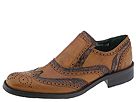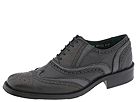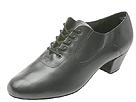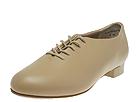Men's Dance Shoes

| 
|

|

|
||||||
|
Kenneth Cole - Ballroom Dance Shoe (Tan Snake)
|
Kenneth Cole - Dance Hall (Brown)
| Capezio Latin Oxford - 2" (Black)
|
Capezio - Tapster (Tan)
|
Monday, July 10, 2006
What are the best clogging shoes? + clog dancing terminology...
I found this on a dancing forum and thought it was interesting...
My question is: What are the best clogging shoes out there?
TRADITIONAL CLOGGING TERMINOLOGY
All traditional clogging steps are made up of some combination of the following basic movements. The movements themselves fall into two groups -Toe Movements and Heel Movements. Each Toe Movement occurs on an upbeat of the music and is followed by a Heel Movement which occurs on the downbeat of the music. There are no silent or syncopated beats in Traditional Clogging. The rhythm of the dance is kept by the heel. Anytime the heel is sounded, the knee is flexed and then straightened on the following upbeat, resulting in the characteristic up and down motion of the dancer's body.
The word "click" is used in the descriptions below to indicate that a tap has contacted the floor. All clicks should have a sharp, clear sound, not scuffed or muffled.
HEEL MOVEMENTS These fall on the downbeat (or bass beat) of the music
HEEL
The weight of the body is already on the ball of the foot when the HEEL movement is done. Snap the heel down, producing a sharp click, and flex the knee downward, distributing the body weight along the entire length of the foot.
STEP
Place the entire foot flat on the floor, producing a click with the toe tap and the heel tap at the same time and transferring the body weight along the full length of the foot while flexing the knee downward.
SLIDE
A down and forward counterpart of the up and back motion of the DRAG (see TOE MOVEMENTS). With the foot flat on the floor and the knee straight, roll your weight up onto the ball of the foot, letting your knee begin to go slack. As the weight of your body begins to drop forward and down, let the instinctive tightening of your thigh muscles save you from a fall by sliding your foot forward (bout the length of your foot) and then letting your heel snap down, producing the click and redistributing your weight along the whole length of your foot. At the end of the SLIDE the knee will be in a flexed position. (Also can be done with both feet on the floor in the same manner.)
TOE MOVEMENTS These fall on the upbeat of the music
TOE
The ball of the foot produces a click while the heel remains out of contact with the floor. TOE implies that the body weight has been transferred to the ball of the foot. The knee should be basically straight.
DOUBLE TOE
Two clicks are produced in the space of on upbeat of music. The ball of the foot strikes the floor during the forward motion of a short kick and the knee straightens (ankle is relaxed and foot angles downward). The knee bends upward immediately and the same foot swings backward with the ball of the foot striking the floor again in the same spot. The heel should not touch the floor. The two motions of the foot are considered to be one movement with no hesitation between them. Normally, the clicks occur slightly in front of the body, but they may be done in other directions as well.
ROCK
A click is produced by transferring the weight onto the ball of the foot slightly behind the body's center of gravity. The knee is in a flexed position at first, causing the body's weight to "rock" back slightly as the center of gravity changes. The opposite foot is always lifted off the floor during a ROCK. The heel of the foot doing the ROCK does not touch the floor, but the knee does straighten.
BRUSH
The foot is allowed to swing from the knee with a pendulum action. The ball of the foot produces a click by striking the floor and continuing in the direction of the swing (which may be to the front, to the rear, or crossing in front or in back of the opposite leg). Movement comes from the hip and the knee joint, and the knee of the BRUSHing foot always bends upward following the click (at the same time as the following heel movement).
DRAG
The foot is flat on the floor and the knee is flexed when the DRAG begins. With a springing motion which moves the weight of the body up and back, straighten the knee allowing momentum to lift you heel slightly off the floor and drag your foot back about half the length of the foot. The weight is distributed along the length of the foot at the end of the movement and there is no distinctive click. (This can also be done with both feet on the floor in the same manner )
NOTE: Much of what is considered to be "traditional" clog dance styling depends on the part of Appalachia the definitions come from, but the following points are frequently raised:
Smooth flowing motions with a constant DRAG-SLIDE incorporated into the footwork- no head bobbing, no arm waving, no jumpy or jerky body actions.
Feet no more than 6 to 8 inches off the floor- no one but the floor should see the bottom of your clogging shoes. No silent or syncopated beats -toe movements are executed on upbeats and heel movements on downbeats.
CONTEMPORARY CLOGGING TERMINOLOGY
Since clogging is a living folk dance, part of what the dance is will be defined by what folks are dancing at any given time. Accordingly, new movements and new ways of using traditional movements are constantly being developed. As well, liberties are being taken with the "rule" of toe movements on upbeats and heel movements on downbeats. At the same time, however, try to remain aware that there is a distinction between what is traditional and what is contemporary so that you can keep your students informed (as well as happy!).
With the above points in mind, the following are the Contemporary Clogging Movements you'll se around the clogging floor these days:
HOP
An extension of SLIDE used in describing any upward motion that causes both feet to lose contact with the floor. The hop occurs with the upward motion taking place on the upbeat of the music and the click produced on the bass beat when the foot comes back into contact with the floor. The knee is flexed downward as you land. Landing after the hop may take place on the same foot that did the push off into the air, or the HOP may be used to change the weight to the opposite foot depending on the demands of the step being done. A foot designator L or R beneath the word HOP on a cuesheet would indicate the foot change.
SLUR
Feet will be slightly apart when a SLUR begins. On the upbeat, draw the toe tap along the floor (giving a slurred tap sound) toward the weight-bearing foot (usually ending across in back). Drop the heel to the floor producing a click on the bass beat. Originally SLUR was separated from the following beat, but today most choreographers assume that you will automatically include the heel sound when using the term SLUR.
CLICK
Describes a motion where the sides of your clogging shoes are touches together. As with slur, most choreographers assume that you will click your heels together on an upbeat and then sound a heel tap on the following bass beat. Several varieties of CLICK exist today and are further defined by the styling terms provided with the step.
KICK
A variation of the BRUSH that simply omits the sound of the toe tap by eliminating any contact with the floor. Leg motion and action is the same as the BRUSH.
STOMP
A strongly accented flatfoot step taking the full weight of the foot.
TOUCH
A term used to imply the same sound and motion as that of a TOE, but the foot ins immediately picked up again without transferring the body weight to that foot.
STAMP
A flatfooted TOUCH
BREAK
The entire side of the foot has been turned sideways and away from the other foot to become flush with the floor. Weight is borne by the other foot.
PIVOT
Describes a motion on the ball of the foot in a given direction. Usually occurs on the upbeat and does not necessarily include dropping the heel on the following bass beat. Therefore, the next intended movement should be written out as well.
PULL
Indicated that the dancer will "scrape" the tip of the clogging shoe along the floor usually toward the other foot. Can be done from the rear, from across in back, from across in front, etc.
BUCK DANCE TERMINOLOGY
Buck Dancing has come to be recognized in clogging circles as a specific style of dancing that differs from flat-footing in that a buck dancer keeps his weight on the balls of the feet and produces clicks by the interchanging of heel and toe movements to make what has been described as a "patter" sound. In the mountains of West Virginia, where I come from, the term "buck dancing" is used to describe any solo freestyle dancing -whether it be traditional clogging, flat-foot or otherwise. By the same token, dancing with a partner is known as a "buck and wing" dance. .
The terms outlined below are used to described movements used in the heel -toe dance style commonly known as "buck dancing":
BALL
The transfer of the body weight in a stepping motion to the ball of the foot with the knee bent slightly.
BOUNCE
The same as BALL, but with a hopping motion instead of a stepping motion. You may BOUNCE on the same foot or use it to change from one foot to another.
DIG
A step (transfer of body weight) onto the hack edge of the heel.
FLANGE
A term used to indicate that the dancer has completely turned the foot over and outward to bring the area of the shoe which covers the last two toes flush with the floor. The heel is aimed upward and weight is borne by the other foot
FLICK
A short back BRUSH of the toe tap (usually following a heel sound from the same foot)
HIT
A touch of the back edge of the heel tap to the floor without any transfer of weight to the floor
POINT
A touch of the tip of the shoe (NOT the ball of the foot) to the floor behind the body (or across in front or in back of the opposite foot, etc.)
SKUFF
A short forward brush with the heel tap striking the floor. Normally, the front portion of the heel tap is the area which produces the click.
SKUFFLE
A short forward and back brush which produces two sounds from the heel tap in one beat of music (&a).
SLIP
A forward chug on the ball of the foot only -no heel tap sound is produced.
SNAP From a foot flat on the floor (normally done as a part of the DRAG on the same foot), the toe of the foot is raised slightly and then immediately dropped again to produce a sound of the toe tap.
Clogging Shoes | Custom Posters & Calendars | Family Vacation Destination
My question is: What are the best clogging shoes out there?
TRADITIONAL CLOGGING TERMINOLOGY
All traditional clogging steps are made up of some combination of the following basic movements. The movements themselves fall into two groups -Toe Movements and Heel Movements. Each Toe Movement occurs on an upbeat of the music and is followed by a Heel Movement which occurs on the downbeat of the music. There are no silent or syncopated beats in Traditional Clogging. The rhythm of the dance is kept by the heel. Anytime the heel is sounded, the knee is flexed and then straightened on the following upbeat, resulting in the characteristic up and down motion of the dancer's body.
The word "click" is used in the descriptions below to indicate that a tap has contacted the floor. All clicks should have a sharp, clear sound, not scuffed or muffled.
HEEL MOVEMENTS These fall on the downbeat (or bass beat) of the music
HEEL
The weight of the body is already on the ball of the foot when the HEEL movement is done. Snap the heel down, producing a sharp click, and flex the knee downward, distributing the body weight along the entire length of the foot.
STEP
Place the entire foot flat on the floor, producing a click with the toe tap and the heel tap at the same time and transferring the body weight along the full length of the foot while flexing the knee downward.
SLIDE
A down and forward counterpart of the up and back motion of the DRAG (see TOE MOVEMENTS). With the foot flat on the floor and the knee straight, roll your weight up onto the ball of the foot, letting your knee begin to go slack. As the weight of your body begins to drop forward and down, let the instinctive tightening of your thigh muscles save you from a fall by sliding your foot forward (bout the length of your foot) and then letting your heel snap down, producing the click and redistributing your weight along the whole length of your foot. At the end of the SLIDE the knee will be in a flexed position. (Also can be done with both feet on the floor in the same manner.)
TOE MOVEMENTS These fall on the upbeat of the music
TOE
The ball of the foot produces a click while the heel remains out of contact with the floor. TOE implies that the body weight has been transferred to the ball of the foot. The knee should be basically straight.
DOUBLE TOE
Two clicks are produced in the space of on upbeat of music. The ball of the foot strikes the floor during the forward motion of a short kick and the knee straightens (ankle is relaxed and foot angles downward). The knee bends upward immediately and the same foot swings backward with the ball of the foot striking the floor again in the same spot. The heel should not touch the floor. The two motions of the foot are considered to be one movement with no hesitation between them. Normally, the clicks occur slightly in front of the body, but they may be done in other directions as well.
ROCK
A click is produced by transferring the weight onto the ball of the foot slightly behind the body's center of gravity. The knee is in a flexed position at first, causing the body's weight to "rock" back slightly as the center of gravity changes. The opposite foot is always lifted off the floor during a ROCK. The heel of the foot doing the ROCK does not touch the floor, but the knee does straighten.
BRUSH
The foot is allowed to swing from the knee with a pendulum action. The ball of the foot produces a click by striking the floor and continuing in the direction of the swing (which may be to the front, to the rear, or crossing in front or in back of the opposite leg). Movement comes from the hip and the knee joint, and the knee of the BRUSHing foot always bends upward following the click (at the same time as the following heel movement).
DRAG
The foot is flat on the floor and the knee is flexed when the DRAG begins. With a springing motion which moves the weight of the body up and back, straighten the knee allowing momentum to lift you heel slightly off the floor and drag your foot back about half the length of the foot. The weight is distributed along the length of the foot at the end of the movement and there is no distinctive click. (This can also be done with both feet on the floor in the same manner )
NOTE: Much of what is considered to be "traditional" clog dance styling depends on the part of Appalachia the definitions come from, but the following points are frequently raised:
Smooth flowing motions with a constant DRAG-SLIDE incorporated into the footwork- no head bobbing, no arm waving, no jumpy or jerky body actions.
Feet no more than 6 to 8 inches off the floor- no one but the floor should see the bottom of your clogging shoes. No silent or syncopated beats -toe movements are executed on upbeats and heel movements on downbeats.
CONTEMPORARY CLOGGING TERMINOLOGY
Since clogging is a living folk dance, part of what the dance is will be defined by what folks are dancing at any given time. Accordingly, new movements and new ways of using traditional movements are constantly being developed. As well, liberties are being taken with the "rule" of toe movements on upbeats and heel movements on downbeats. At the same time, however, try to remain aware that there is a distinction between what is traditional and what is contemporary so that you can keep your students informed (as well as happy!).
With the above points in mind, the following are the Contemporary Clogging Movements you'll se around the clogging floor these days:
HOP
An extension of SLIDE used in describing any upward motion that causes both feet to lose contact with the floor. The hop occurs with the upward motion taking place on the upbeat of the music and the click produced on the bass beat when the foot comes back into contact with the floor. The knee is flexed downward as you land. Landing after the hop may take place on the same foot that did the push off into the air, or the HOP may be used to change the weight to the opposite foot depending on the demands of the step being done. A foot designator L or R beneath the word HOP on a cuesheet would indicate the foot change.
SLUR
Feet will be slightly apart when a SLUR begins. On the upbeat, draw the toe tap along the floor (giving a slurred tap sound) toward the weight-bearing foot (usually ending across in back). Drop the heel to the floor producing a click on the bass beat. Originally SLUR was separated from the following beat, but today most choreographers assume that you will automatically include the heel sound when using the term SLUR.
CLICK
Describes a motion where the sides of your clogging shoes are touches together. As with slur, most choreographers assume that you will click your heels together on an upbeat and then sound a heel tap on the following bass beat. Several varieties of CLICK exist today and are further defined by the styling terms provided with the step.
KICK
A variation of the BRUSH that simply omits the sound of the toe tap by eliminating any contact with the floor. Leg motion and action is the same as the BRUSH.
STOMP
A strongly accented flatfoot step taking the full weight of the foot.
TOUCH
A term used to imply the same sound and motion as that of a TOE, but the foot ins immediately picked up again without transferring the body weight to that foot.
STAMP
A flatfooted TOUCH
BREAK
The entire side of the foot has been turned sideways and away from the other foot to become flush with the floor. Weight is borne by the other foot.
PIVOT
Describes a motion on the ball of the foot in a given direction. Usually occurs on the upbeat and does not necessarily include dropping the heel on the following bass beat. Therefore, the next intended movement should be written out as well.
PULL
Indicated that the dancer will "scrape" the tip of the clogging shoe along the floor usually toward the other foot. Can be done from the rear, from across in back, from across in front, etc.
BUCK DANCE TERMINOLOGY
Buck Dancing has come to be recognized in clogging circles as a specific style of dancing that differs from flat-footing in that a buck dancer keeps his weight on the balls of the feet and produces clicks by the interchanging of heel and toe movements to make what has been described as a "patter" sound. In the mountains of West Virginia, where I come from, the term "buck dancing" is used to describe any solo freestyle dancing -whether it be traditional clogging, flat-foot or otherwise. By the same token, dancing with a partner is known as a "buck and wing" dance. .
The terms outlined below are used to described movements used in the heel -toe dance style commonly known as "buck dancing":
BALL
The transfer of the body weight in a stepping motion to the ball of the foot with the knee bent slightly.
BOUNCE
The same as BALL, but with a hopping motion instead of a stepping motion. You may BOUNCE on the same foot or use it to change from one foot to another.
DIG
A step (transfer of body weight) onto the hack edge of the heel.
FLANGE
A term used to indicate that the dancer has completely turned the foot over and outward to bring the area of the shoe which covers the last two toes flush with the floor. The heel is aimed upward and weight is borne by the other foot
FLICK
A short back BRUSH of the toe tap (usually following a heel sound from the same foot)
HIT
A touch of the back edge of the heel tap to the floor without any transfer of weight to the floor
POINT
A touch of the tip of the shoe (NOT the ball of the foot) to the floor behind the body (or across in front or in back of the opposite foot, etc.)
SKUFF
A short forward brush with the heel tap striking the floor. Normally, the front portion of the heel tap is the area which produces the click.
SKUFFLE
A short forward and back brush which produces two sounds from the heel tap in one beat of music (&a).
SLIP
A forward chug on the ball of the foot only -no heel tap sound is produced.
SNAP From a foot flat on the floor (normally done as a part of the DRAG on the same foot), the toe of the foot is raised slightly and then immediately dropped again to produce a sound of the toe tap.